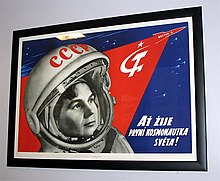Sovietwave
| Sovietwave | |
|---|---|
 Valentina Vladimirovna Tereshkova, the first woman in space. Common motifs of Sovietwave are retrofuturistic dreams of innovation and musical elements evocative of space. | |
| Stylistic origins |
|
| Cultural origins | Early 2010s |
| Typical instruments | digital audio workstation |
| Other topics | |
| |
Sovietwave (also spelled Soviet wave[1] or Soviet-wave[2]) is a subgenre of synthwave music which originates from a number of post-Soviet states, primarily Russia. It is characterized by themes associated with the Soviet Union and is part of the phenomenon of nostalgia for the Soviet Union.[1]
History of the genre[]
The first attempts to bring Soviet nostalgia to modern music began in the 2000s, when trance music was at the peak of its popularity. Trance music duo PPK used the melodies of Soviet electronic music as the basis of their compositions. "Electrosound nostalgia" appeared in the mid-2010s, which is when the genre started to become more well defined.[3] The main inspirations for composers of Sovietwave are often the emotions and collective cultural memories associated with the Soviet Union during the 1980s.[4] Lyudmila Shevchenko, a scholar from the Jan Kochanowski University notes that the genre is one of the manifestations of the “nostalgic myth”, a “vivid, sensual and lively” mythical image based on the recent past.[5] Sovietwave became popular in most post-Soviet countries in the second half of the 2010s.[6] It is related to the global proliferation of the synthwave genre, and nostalgia for 1980s Soviet culture within previous Soviet-bloc states.[7]
Style[]
Sovietwave is based on modern electronic music trends such as lo-fi, ambient and synth-pop, as well as the electronic music of the late Soviet Union.[8] Despite Sovietwave's widespread use of sampling from radio programs and speeches, the genre is not overtly political.[8] Sovietwave music is characterized by an emphasis on the cultural, political and scientific aspects of USSR citizen life,[6][9] with excerpts from educational films and speeches by Soviet statesmen being used primarily to create a nostalgic experience for the listener.[6] Sovietwave usually reflects dreams about space and progress which disappeared with the USSR, together with positive childhood reminiscences and utopic, philanthropic hopes.[6][9]
The genre is influenced by the music of old Soviet films and cartoons, such as The Mystery of the Third Planet, Guest from the Future, The Adventures of the Elektronic, Courier, Leopold the Cat, Moscow-Cassiopeia, Office Romance, One Hundred Days After Childhood, Three from Prostokvashino, comedies of Leonid Gaidai, old episodes of Yeralash, and others. Common influences of the genre are soviet composers Eduard Artemyev, Aleksandr Zatsepin and music groups Zodiac,[8] Alliance,[9] Bioconstructor, Mayak, Forum, and New Collection. However, the genre is also influenced by the work of western artists popular in the USSR, such as Depeche Mode, Digital Emotion, Modern Talking.[7]
See also[]
- Soyuzmultfilm
- Hardvapour
References[]
- ^ a b "Russia's musical new wave embraces Soviet chic: Nostalgic young musicians seek connection to culture of the past", The Guardian
- ^ "MUSTELIDE - "В Mustelide мне безумно нравится быть одной" - Звуки.Ру". Zvuki.ru. Retrieved 2019-10-28.
- ^ "SOVIETWAVE - interview by Peek-A-Boo magazine". www.peek-a-boo-magazine.be. Retrieved 2019-10-28.
- ^ A Guide to Sovietwave: Six Artists to Know|Bandcamp Daily
- ^ Szewczenko, Ludmiła (2019-08-08). "Ностальгия в системе базовых оппозиций "добро" и "зло" в автодокументальных произведениях Людмилы Улицкой "Детство 45–53: а завтра будет счастье" и Светланы Алексиевич "Время секонд хэнд"". Studia Rossica Posnaniensia (in Russian). 44 (44 t1): 53–62. doi:10.14746/strp.2019.44.1.6. ISSN 0081-6884. S2CID 212909669.
- ^ a b c d REVIVAL OF SOVIET ELECTRO // «Boombarash» magazine № 7/2015 Интервью с группой «Артек Электроника»
- ^ a b Краснощеков, Владимир Александрович (2017-09-22). "Евродиско в России: из мейнстрима в андеграунд". Обсерватория культуры (in Russian). Retrieved 2019-11-10.
- ^ a b c Ridus. RU. Andrey Krasnoshchekov: Electrosound nostalgia. In Russian
- ^ a b c Yandex.Zen. Musical hearse: SovietWave - Nostalgia in every note. In Russian
External links[]
- The Guardian: Russia’s musical new wave embraces Soviet chic
- History & Culture Academy of Latgale The Nostalgic Phenom of the Sovietwave Music
- Peek-a-boo music magazine SOVIETWAVE. Cosmonauts' day special
- Internet radio station «Советская волна», 24-hour broadcasting music in the genre sovietwave.
- 2010s in music
- Nostalgia for the Soviet Union
- Retro style
- Russian music
- Synthwave
- 2010s neologisms